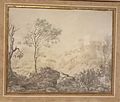Jean-François Thomas de Thomon
Jean-François Thomas de Thomon , born Jean-François Thomas , ( Russian Жан-Франсуа Тома де Томон Schan-Fransua Toma de Tomon ; * April 12, 1760 ; † August 23 jul. / September 4, 1813 greg. In St. Petersburg ) was a French - Russian architect .
Life
At the age of 17, Thomas was accepted into the class of Julien-David Le Roy (1724-1803) of the Académie royale d'architecture , where Charles Percier and Pierre-François-Léonard Fontaine also studied. Without success he sought a scholarship for a trip to Italy , so that he traveled to Rome in 1785 at his own expense . There he took part in lectures by the Académie de France à Rome in the Palazzo Mancini without admission , which François-Guillaume Ménageot tolerated for years. Thomas studied ancient architecture and specialized in classicism . He made drawings , watercolors and oil paintings of Roman buildings and landscapes in the manner of Hubert Roberts and Nicolas Poussins .
Thomas returned to France in 1789 and became the architect of the Comte d'Artois . Due to the French Revolution , Thomas could no longer work as an ardent royalist in France, so that he settled in Vienna in 1789 , where he took the noble name Thomas de Thomon. He became known for building a gallery in the Lubomirskis' castle in Łańcut . In 1792 he met the Russian ambassador in Vienna, Dmitri Wladimirowitsch Golitzyn . In Vienna, Thomas executed various buildings for the Esterházys in 1794. A bath house in Eisenstadt has been preserved .
In 1798 Thomas accepted an invitation from his brother Alexander Thomas, who lived in Moscow , and traveled to Russia via Hamburg and Riga . He pretended to be a Swiss born in Bern , since French were denied entry on suspicion of revolutionary attitudes. Thomas initially worked for the Golitzyns on their country estates. In 1799 he settled in St. Petersburg at the invitation of Alexander Mikhailovich Golitsyn . In 1800 he began to teach at the Imperial Academy of the Arts .
In 1802, Thomas received the order from Alexander I to rebuild the Kamenny Theater , built by Antonio Rinaldi in 1775 , which then continued until 1805. He was appointed court architect and remained architect of the theater until it burned down in 1811. Like Giacomo Quarenghi, he took part in the competition for the reconstruction, which Antoine-François Mauduit won.
In 1805, Thomas Quarenghi's project for the construction of the stock exchange on Vasilyevsky Island took over , as the building, erected in 1787, no longer met the cityscape and requirements. Thomas realized a great building in the form of an ancient peripterus based on the model of the Hera temple in Paestum . The gable was decorated with sculptures by Ivan Prokofjewitsch Prokofiev and Feodossi Fyodorowitsch Shchedrin . At the same time, Thomas carried out the project to redesign the eastern tip of Vasilyevsky Island with the two Rostra columns on the stock exchange. In 1806 Thomas won the competition for the mausoleum of Paul I for his wife in Pavlovsk , which he built in the form of an ancient temple.
Then Thomas built the old Odessa Opera House in the classical style (1804-1809), the military hospital in Odessa (1806-1821), the monument inaugurated in 1811 with the honorary column by Feodossi Fyodorowitsch Shchedrin in memory of the Battle of Poltava on the Round Square in Poltava , Fountain along the road from St. Petersburg to Tsarskoe Selo (1809, one in front of the Kazan Cathedral and another in Victory Park) and the salt warehouse on the Neva . He rebuilt the house of Graefing AG Laval from 1805–1810. He published his drawings and plans in an anthology. From 1811 Thomas taught at the new Institute of the Transport Engineers Corps headed by Agustín de Betancourt .
When Thomas Mauduits inspected the unfinished new building of the Kamenny Theater in 1813, he fell from the scaffolding and died soon after of the injuries. He was buried in the Smolensk Cemetery in St. Petersburg . In 1955 he was reburied in the Lazarus Cemetery at the Alexander Nevsky Monastery .
Works
The Roman Emperor is Pleaded for Pity (1798), Speed Art Museum, Louisville, Kentucky
Landscape with Ancient People (1799), Pushkin Museum
Fountain with sphinxes , Pulkovskoye Schosse, St. Petersburg
Neptune Fountain , Sennaya Ploshchad, St. Petersburg
Individual evidence
- ↑ Томон (Тома de Thomon) . In: Brockhaus-Efron . XXXIIIa, 1901, pp. 480 ( Wikisource ).
- ↑ Шуйский В. К .: Тома де Томон . Лениздат, Leningrad 1981.
- ↑ a b c Шуйский В. К .: Золотой век барокко и классицизма в Санкт-Петербургу . 2008, ISBN 978-5-9524-3777-7 .
- ↑ a b c ТОМА де ТОМОН Жан Франсуа (1760–1813) THOMAS de THOMON Jean François (1760–1813) (accessed July 14, 2018).
- ↑ a b ИСТОРИЯ САНКТ-ПЕТЕРБУРГА, / АРХИТЕКТОРЫ: Жан Франсуа Тома де Томон (accessed July 14, 2018).
- ↑ J.-F. Thomas de Thomon: Traité de peinture, précédé de l'origine des arts ( с приложением гравюр, чертежей и планов) . St. Petersburg, 1806.
- ↑ Лаваль дом (accessed July 14, 2018).
- ↑ J.-F. Thomas de Thomon: Recueil des façades des principaux monuments construits à St.-Pétersbourg par Thomas de Thomon . St. Petersburg 1806.
| personal data | |
|---|---|
| SURNAME | Thomas de Thomon, Jean-François |
| ALTERNATIVE NAMES | Тома де Томон, Жан-Франсуа (Russian) |
| BRIEF DESCRIPTION | Franco-Russian architect |
| DATE OF BIRTH | April 12, 1760 |
| DATE OF DEATH | September 4, 1813 |
| Place of death | St. Petersburg |








